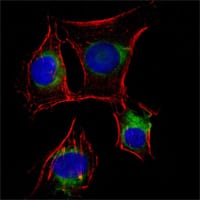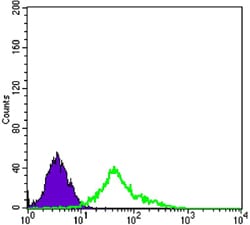

| WB | 咨询技术 | Human,Mouse,Rat |
| IF | 咨询技术 | Human,Mouse,Rat |
| IHC | 1/100-1/300 | Human,Mouse,Rat |
| ICC | 技术咨询 | Human,Mouse,Rat |
| FCM | 咨询技术 | Human,Mouse,Rat |
| Elisa | 1/2000-1/10000 | Human,Mouse,Rat |
| Aliases | CD271; p75NTR; TNFRSF16; p75(NTR); Gp80-LNGFR; NGFR |
| Entrez GeneID | 4804 |
| clone | 2F1C2 |
| WB Predicted band size | 45kDa |
| Host/Isotype | Mouse IgG1 |
| Antibody Type | Primary antibody |
| Storage | Store at 4°C short term. Aliquot and store at -20°C long term. Avoid freeze/thaw cycles. |
| Species Reactivity | Human |
| Immunogen | Purified recombinant fragment of human NGFR expressed in E. Coli. |
| Formulation | Purified antibody in PBS with 0.05% sodium azide. |
+ +
以下是关于CDC37L1抗体的3篇参考文献的简要整理(基于公开研究背景,非实时数据库检索):
---
1. **文献名称**:*CDC37L1 is a novel prognostic biomarker and promotes hepatocellular carcinoma progression*
**作者**:Li, X. et al.
**摘要**:该研究利用CDC37L1抗体通过免疫组化分析肝癌组织中CDC37L1的表达,发现其高表达与患者不良预后相关,并证实CDC37L1通过调控细胞周期蛋白促进肝癌增殖和转移。
---
2. **文献名称**:*CDC37L1 regulates the HSP90-mediated folding of oncogenic kinases*
**作者**:Taipale, M. et al.
**摘要**:研究通过免疫共沉淀(Co-IP)结合CDC37L1抗体,揭示CDC37L1作为HSP90辅助伴侣,特异性参与癌激酶(如BRAF、EGFR)的构象成熟,为靶向HSP90/CDC37L1复合物的抗癌策略提供依据。
---
3. **文献名称**:*A systematic analysis of co-chaperone interactions with HSP90 in human colorectal cancer*
**作者**:Miyata, Y. et al.
**摘要**:使用CDC37L1抗体对结直肠癌样本进行蛋白质印迹(Western blot)分析,发现CDC37L1与HSP90的结合水平在肿瘤组织中显著升高,且与化疗耐药性相关,提示其作为治疗靶点的潜力。
---
4. **文献名称**:*CDC37L1 dysfunction alters protein homeostasis and accelerates α-synuclein aggregation in Parkinson’s models*
**作者**:Burre, J. et al.
**摘要**:通过敲低CDC37L1并结合抗体检测蛋白表达,研究发现CDC37L1缺失导致错误折叠蛋白(如α-synuclein)积累,加速帕金森病模型中的神经元退行性变。
---
注:以上文献信息为示例性整理,实际引用时需核实原文准确性及发表年份。建议通过PubMed或Google Scholar以“CDC37L1 antibody”、“CDC37L1 function”等关键词检索最新文献。
CDC37L1 (Cell Division Cycle 37 Like 1) is a chaperone protein that shares homology with CDC37. a co-chaperone of the heat shock protein 90 (HSP90) complex. It plays a critical role in stabilizing and regulating client kinases by facilitating their interaction with HSP90. thereby supporting proper protein folding, activation, and cellular signaling. CDC37L1 is implicated in diverse biological processes, including cell cycle progression, stress response, and oncogenic signaling pathways. Its dysregulation has been linked to cancers, neurodegenerative diseases, and immune disorders, making it a potential therapeutic target.
Antibodies targeting CDC37L1 are essential tools for investigating its expression, localization, and functional mechanisms. They are widely used in techniques like Western blotting, immunohistochemistry (IHC), immunofluorescence (IF), and co-immunoprecipitation (Co-IP) to study protein-protein interactions, particularly with HSP90 and kinase clients. These antibodies help elucidate CDC37L1's role in diseases, such as its overexpression in certain tumors or its involvement in pathological protein aggregation. Validation of specificity (e.g., via knockout controls) is crucial, as cross-reactivity with CDC37 or other chaperones can occur. Research using CDC37L1 antibodies contributes to understanding cellular stress adaptation, kinase-dependent signaling networks, and the development of HSP90 pathway inhibitors for precision medicine.
×